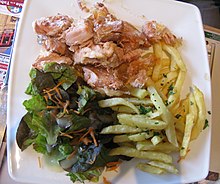This article has multiple issues. Please help improve it or discuss these issues on the talk page. (Learn how and when to remove these template messages)
This article relies largely or entirely on a single source. Relevant discussion may be found on the talk page. Please help improve this article by introducing citations to additional sources.Find sources: "Potjevleesch" – news · newspapers · books · scholar · JSTOR (February 2019)
This article possibly contains original research. Please improve it by verifying the claims made and adding inline citations. Statements consisting only of original research should be removed. (February 2019) (Learn how and when to remove this message)
This article may contain excessive or inappropriate references to self-published sources. Please help improve it by removing references to unreliable sources where they are used inappropriately. (February 2019) (Learn how and when to remove this message)
This article needs additional citations for verification. Please help improve this article by adding citations to reliable sources. Unsourced material may be challenged and removed.Find sources: "Potjevleesch" – news · newspapers · books · scholar · JSTOR (August 2017) (Learn how and when to remove this message)
(Learn how and when to remove this message)
Potjevleesch is a traditional French Flemish dish, which can be translated into English as "potted meat".
It is traditionally made in a ceramic dish from three or four different types of meat and held together with natural gelatin coming from the meats used. The meat, along with sliced onions, salt, pepper, thyme and bay leaves, is covered in water or a mixture of water and vinegar and then cooked either on a low heat in the oven or on a low flame on top of the stove for 3 hours. After cooking, the dish is chilled then placed in the refrigerator and served cold.[1]
It is customary to serve it with chips on top of it for melting down the gelatin.
